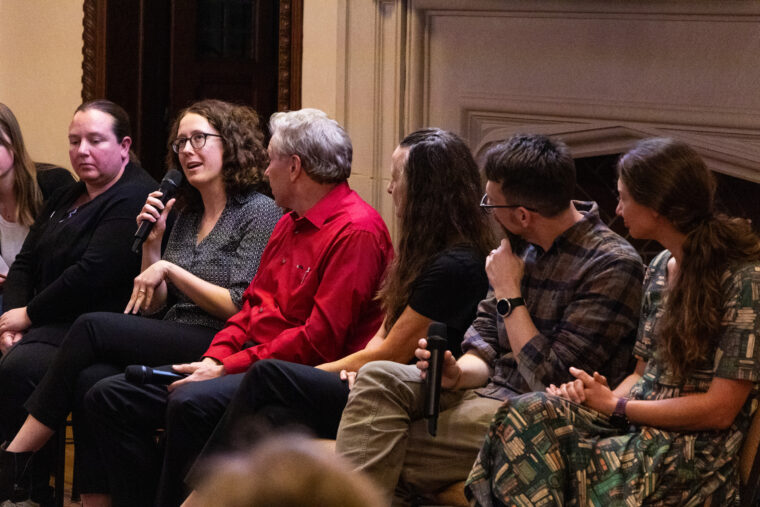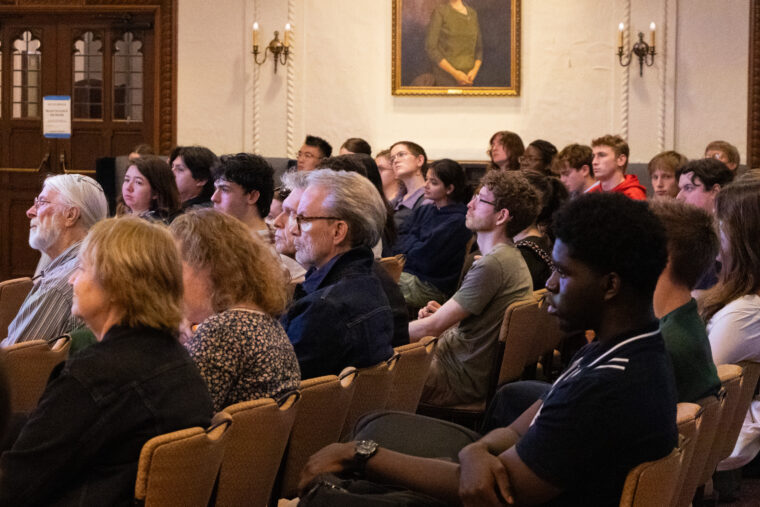St. Louis community organizers and WashU professors gather to discuss religion and the env
November 9, 2025

6 presenters gave lightning talks and answered questions at Wednesday’s event (Jonah Glass | Staff Photographer)
The Department of English hosted “A Conversation on Religion and the Environment: Academia, Community, Activism” to discuss across disciplines the intersectionality of religion and the environment in the St. Louis and WashU communities. Speakers at Wednesday’s event ranged from religious organization leaders to engineering and biology professors.
The event began with short presentations called “lighting talks” from each of its six presenters. Beth Gutzler talked about her work with the St. Louis community in her role as Lead Environmental Justice Organizer for Metropolitan Congregations United, an organization that brings people of different faiths together to promote political change.
“We go out beyond the faith borders into the community to change public policy for the county,” she said.
While religion is oftentimes centered around study and prayer, Gutzler emphasized the importance of taking action based on religious lessons.
“When it comes to our sustainability, our environmental values that come out of our faith traditions, we do have to go beyond the book study and go do the work.”
Gutzler said she partnered with the lab of fellow panelist and Head of the Division of Engineering Education Jay Turner to install air monitors in local religious institutions to help improve air quality.
After Gutzler spoke, Senior Lecturer in Environmental Studies Suzanne Loui gave her lightning talk on how to implement faith into environmentalism, especially in a time of eco-anxiety. Specifically, Loui discussed shifting perspectives by considering three simultaneously true statements: The world is awful, the world is much better, and the world can be much better.
“Environmental modernism is a theory of environmental progress which suggests that we should atone for our sins against nature and honor our technological accomplishments and progress which have improved the quality of human and environmental life,” Loui said.
A handful of Loui’s students attended the event to hear her speak. One student, sophomore Grace Wereley-Bross, is in Loui’s Environmental Modernism class. She said that she enjoyed seeing one of her class’s projects in Loui’s presentation. The project consisted of designing a logo and writing an explanation to show the complexity of environmental issues.
Werele-Bross said that attending the event allowed her to learn about the environmental justice work that faith-based organizations are doing in St. Louis.
“I don’t know that much about it. I hear more about the science side of things on campus,” Werele-Bross said.
Next, Assistant Professor of English Bernadette Myers spoke about the connections between her research on literature and culture in early modern England and how humans situate the environment in narratives. She focused on the example ofthe London Stone, a landmark in the United Kingdom, and how natural objects have been personified in literature and art.
“The environment isn’t something that’s just out there, separate from us,” Myers said. “It’s co-created. It’s relational, and sometimes the stories we tell can help us see those relationships more clearly.”
On the other end of the humanities–hard sciences spectrum, Associate Professor in the Department of Biology and Environmental Studies Program Rachel Penczykowski spoke next about her research on the relationships between the environment and disease in plants, specifically in the genus plantago. Species of plants in the plantago genus, unlike most plants studied for disease, are inedible but have traditional medicinal uses.
“These plants, they’re easy to miss. They’re not especially showy. They do really well along roadsides and other places where they get trampled by animals or humans,”Penczykowski said.
Penczykowski’s lab focuses on urban environments and the variations that can occur on small geographic scales due to climate variability.
“We have twenty-two parks across the St. Louis region that we survey monthly for infection levels of plantago,” Penczykowski said. “Shade is very patchy, and it leads to all sorts of interesting spatial patterns of disease that map out to broader patterns. Those patterns are happening on top of underlying patterns that have to do with things like urban temperature and urban land use, and all of that happens in the particular climatic context of St Louis.”
After Penczykowski’s biology-focused presentation, Founder and Executive Director of Brugmansia Ministries Josh Richardson talked about the work his interfaith nonprofit organization does.
“My organization works on emotional, spiritual, and physical resilience,” Richardson said.
Richardson said that faith communities are “frontline workers” because they are the first and last resources people go to when in need of hope or help. He added that as climate change presents moral and tangible problems, more economic and futuristic uncertainty arises.
“When all the other services run out and they talk to every nonprofit, they go to a faith community,” Richardson said.
Richardson said that Brugmansia does not solely offer thoughts and prayers. Instead, they offer action and solutions including resources for infrastructure after flooding and other natural disasters.
The lighting talks concluded with Turner, who spoke about the intersection between gender, religion, and the environment. He said that women spearheaded the work on combatting air pollution in 1930s and 40s St. Louis. He said that it was the imposed gender role of women as homemakers and caretakers that placed this responsibility on women.
Turner went on to explain how women’s domestic roles and religion were intertwined.
“If you had to pick one phrase from that era of the 1930s and 1940s that propelled this forward, it was a rallying cry around cleanliness is next to godliness,” Turner said.
Different religions and sects of religions have their own beliefs on the environment, Turner said. Some Evangelical Christians, for example, preach that a reckoning or apocalypse is imminent so it is not our duty or worthwhile to fight against climate change.

Attendees watch on during the event (Jonah Glass | Staff Photographer)
After the six lightning talks, the panel was turned to Q&A with prepared questions and questions from the audience.
Freshman Leia Karczmer said that she originally attended the event for extra credit in a class, but was able to find worthwhile connections to other classes she was taking,
“I was really not looking forward to it,” Karczmer said. “To see all of the things I’ve been learning in most of my classes come together at this event was very cool.”
If her teacher hadn’t incentivized her to go, Karczmer never would have made these interdisciplinary connections, she said.
“As a WashU student, everyone is very motivated and very busy, and so it’s hard to carve out time to actually go to these things,” Karczmer said. “Now that my teacher did motivate me to go, I probably will go to more events in the future like this.”
Search
RECENT PRESS RELEASES
Related Post



